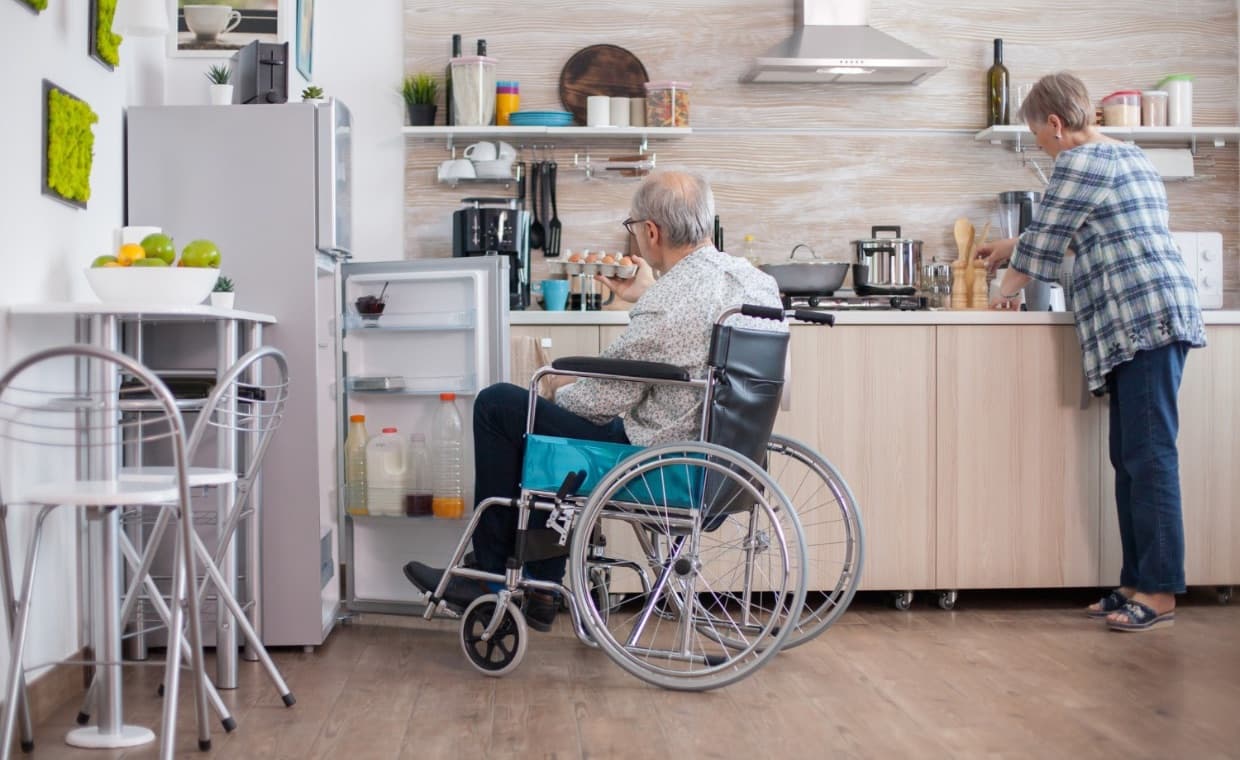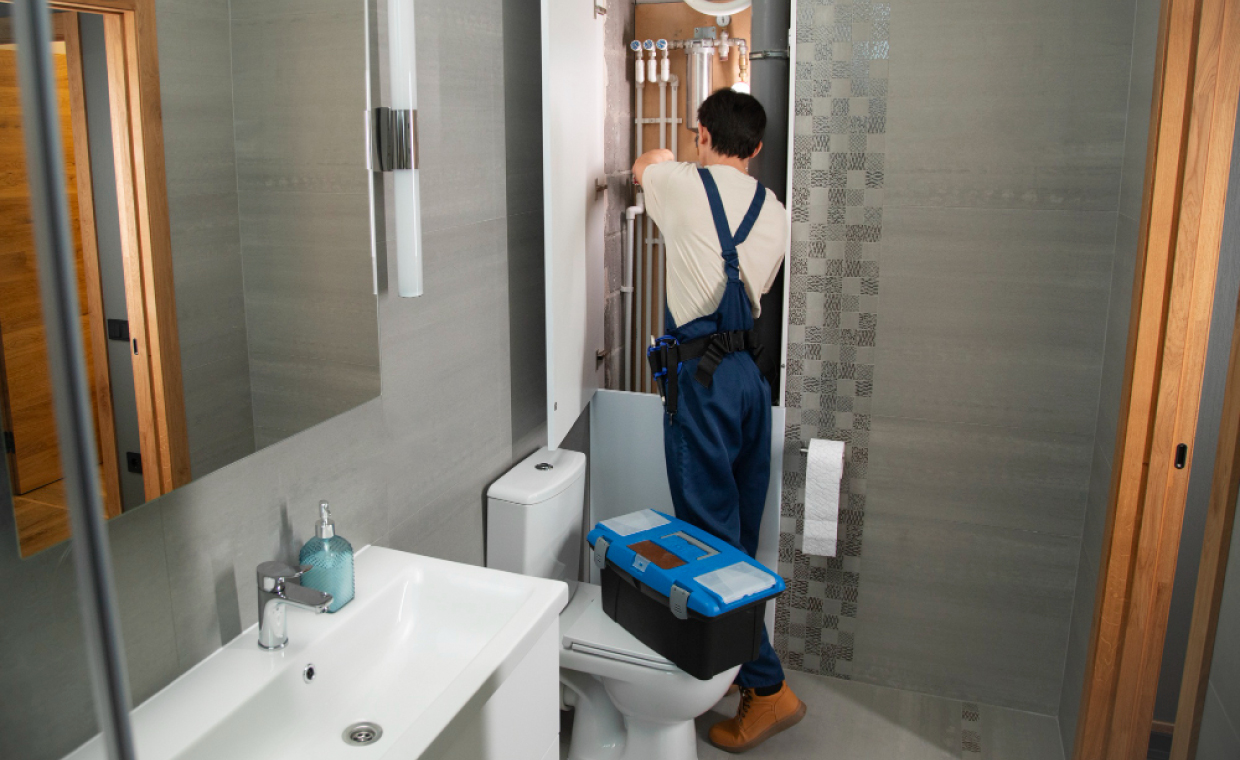
Creating a kitchen space that caters to the needs of elderly individuals, especially those with mobility challenges, involves thoughtful planning and design. By reimagining your kitchen to include kitchen chairs with wheels, you can create a more accessible and comfortable environment that promotes independence and safety for older adults. Today we will guide you through kitchen design tips for elderly to make it more accessible.
Things to Consider while Designing Kitchen for Senior Citizens
01. Understanding the Needs of the Elderly

Before embarking on a kitchen redesign, it is essential to understand the unique needs and challenges faced by elderly individuals with mobility issues. As people age, tasks that were once simple, such as reaching for items or moving around the kitchen, can become difficult or even hazardous. Mobility challenges can arise from a variety of conditions, such as arthritis, balance disorders, or muscle weakness. A kitchen designed with accessibility in mind can significantly improve the quality of life for seniors by making everyday tasks easier and safer.
02. Benefits of Kitchen Chairs with Wheels

Kitchen chairs with wheels are a practical solution for enhancing mobility and comfort in the kitchen. These chairs offer several benefits, including:
- Ease of Movement: Chairs with wheels allow individuals to move around the kitchen without having to stand or walk, reducing the risk of falls and fatigue. This is particularly beneficial for seniors who may tire easily or have balance issues.
- Increased Independence: With wheeled chairs, seniors can move between different workstations in the kitchen, such as the sink, stove, and countertop, without needing assistance. This promotes a sense of independence and autonomy.
- Versatility: Many wheeled kitchen chairs are designed to be adjustable, allowing users to change the height or recline the backrest to suit their comfort needs. This adaptability makes it easier for seniors to perform tasks like food preparation or dining.
03. Redesigning Your Kitchen Layout

When redesigning your kitchen to accommodate kitchen chairs with wheels, consider the following layout adjustments to maximize accessibility and functionality:
I. Open Floor Plan
An open floor plan can greatly enhance mobility in the kitchen. By removing unnecessary barriers and creating clear pathways, you can ensure that wheeled chairs can move freely without obstructions. Consider removing kitchen islands or large dining tables that may impede movement.
II. Accessible Countertops
Lowering countertop heights or installing adjustable countertops can make it easier for seniors to reach and use the workspace from a seated position. Consider installing pull-out shelves or drawers within easy reach to minimize bending or stretching. To make it easier for seniors or disabled people to cook their food in the kitchen, consider making plenty of space for a cooking chair for disabled or elderly people.
III. Appliance Placement
Place frequently used appliances, such as microwaves and ovens, at accessible heights to reduce the need for reaching or bending. Wall-mounted ovens at waist height can be easier to use than traditional floor-level ovens. Similarly, ensure that the refrigerator is easily accessible without needing to move heavy items or reach high shelves.
04. Flooring Considerations

The choice of flooring can significantly impact the ease with which wheeled chairs move around the kitchen. Opt for smooth, non-slip flooring materials that allow for easy gliding of chairs without the risk of tripping or slipping. Materials such as vinyl or laminate can provide a durable and easy-to-maintain surface.
05. Lighting and Safety Features

Good lighting is crucial in preventing accidents and enhancing the usability of the kitchen. Ensure that the kitchen is well-lit, with task lighting over key areas such as the stove, sink, and countertops. Motion-activated lights can be a convenient addition, reducing the need to fumble for switches in the dark.
Additionally, consider installing safety features such as grab bars near workstations and slip-resistant mats in front of the sink and stove. These features can provide extra support and prevent accidents.
06. Creating a Comfortable and Welcoming Environment

The kitchen should not only be functional but also a welcoming and comfortable space. Consider adding soft furnishings, such as cushions or padded seating, to enhance comfort for seniors who may spend extended periods sitting. Personalize the space with decorative touches that reflect the tastes and preferences of the individuals using it, creating a warm and inviting atmosphere.
By carefully considering these design elements, you can transform your kitchen into a space that is not only accessible but also enjoyable for seniors. In the next part, we will explore specific furniture and equipment recommendations, as well as practical tips for implementing these changes to make your kitchen a more senior-friendly environment.
Implementing Changes for a Senior-Friendly Kitchen with Wheeled Chairs
Creating a kitchen environment that caters to elderly individuals with mobility challenges requires thoughtful selection of furniture and equipment. The focus should be on enhancing accessibility, safety, and comfort. Here are some comprehensive steps to ensure your kitchen is as senior-friendly as possible.
01. Selecting and Using Kitchen Chairs with Wheels

Choosing the right kitchen chairs with wheels is crucial for creating a functional and comfortable space for seniors. These chairs must be versatile, stable, and easy to maneuver to accommodate daily kitchen activities effectively.
02. Features to Consider in Kitchen Chairs

- Adjustability: Opt for chairs that allow for adjustable seat heights and backrests. This feature is essential for accommodating different tasks, whether dining, cooking, or reaching for items on countertops. Adjustable chairs ensure that seniors can maintain an ergonomic posture, reducing the strain on their back and joints.
- Swivel Functionality: Chairs that swivel make it easier for users to turn and access various parts of the kitchen without having to move the entire chair. This functionality minimizes physical exertion and supports smooth transitions between different kitchen areas.
- Sturdy Construction: It is imperative that the chairs have a robust build, with frames capable of supporting weight and regular use. High-quality materials ensure longevity and stability, reducing the risk of tipping over and providing peace of mind.
- Brakes and Locking Mechanisms: For safety, chairs should be equipped with reliable brakes or locking mechanisms to prevent accidental movement. This feature is particularly important when performing tasks that require steadiness, such as chopping or stirring.
03. Designing the Kitchen Layout

An effective kitchen layout is key to ensuring ease of movement and accessibility for seniors. Consider an open-plan design to eliminate barriers and provide ample space for maneuvering with wheeled chairs. Here’s how to structure the layout for maximum accessibility:
I. Open Floor Design
Remove unnecessary obstacles such as kitchen islands or large dining tables that can impede movement. The goal is to create wide, clear pathways that allow easy navigation around the kitchen. An open layout enables seniors to move freely and safely, reducing the risk of accidents and enhancing their ability to participate in kitchen activities.
II. Accessible Countertops and Storage
Lowering countertop heights or installing adjustable countertops can make it easier for seniors to reach and work comfortably from a seated position. Pull-out shelves or drawers within easy reach minimize the need for bending or stretching, making everyday tasks more manageable. Use lower cabinets for storing frequently used items and consider pull-down shelving units for upper cabinets, allowing seniors to access high shelves without the need for a step stool.
III. Appliance Placement
Strategically placing appliances at accessible heights is crucial. Wall-mounted ovens at waist height, easy-to-open refrigerators, and counter-level microwaves are essential for ensuring that seniors can access and use kitchen appliances safely. Ensure that controls are easy to operate, with clear labeling and simple interfaces to accommodate potential visual or cognitive impairments.
04. Enhancing Safety and Comfort

Beyond layout and furniture, incorporating safety features and comfort elements is vital to creating a welcoming kitchen environment.
I. Safe Flooring
Choose flooring that is smooth yet non-slip to facilitate the easy movement of wheeled chairs. Vinyl or laminate flooring is durable and provides a stable surface that minimizes the risk of slips and falls. Avoid rugs or mats that could catch on wheels, which could create a tripping hazard.
II. Lighting and Safety Features
Proper lighting is essential for maintaining a safe kitchen environment. Install ample lighting over work areas such as countertops, sinks, and stoves to enhance visibility. Motion-activated lights can be particularly useful, reducing the need to reach for light switches in the dark. Additional safety features like grab bars near workstations and slip-resistant mats in front of the sink and stove can offer support and prevent accidents.
05. Creating a Comfortable Atmosphere
A senior-friendly kitchen should not only be functional but also inviting. Incorporate soft furnishings like cushions on chairs to enhance comfort during prolonged periods of sitting. Personalize the space with decorative touches that reflect the tastes and preferences of the seniors using it, fostering a warm and welcoming atmosphere that encourages them to spend time in the kitchen.
06. Encouraging Independence and Social Engagement

A kitchen that is designed to accommodate the needs of seniors not only supports physical accessibility but also encourages independence and social interaction. With the ability to move freely and perform tasks with minimal assistance, seniors can enjoy a greater sense of autonomy and participate more actively in their daily lives.
07. Social Benefits
A well-designed kitchen encourages social engagement, allowing seniors to host family gatherings or enjoy meals with loved ones in a space that is both safe and comfortable. This social interaction is crucial for emotional well-being, reducing feelings of isolation and enhancing the overall quality of life.
By implementing these kitchen design tips for elderly, your kitchen can become a haven for elderly or disabled individuals, promoting safety, independence, and joy. With the right design elements and thoughtful consideration of their needs, seniors can enjoy a kitchen that supports their lifestyle and enhances their daily experience without having to worry about getting around safely in their kitchen.
And before you leave, don’t forget to read the following article on kitchen design:






























